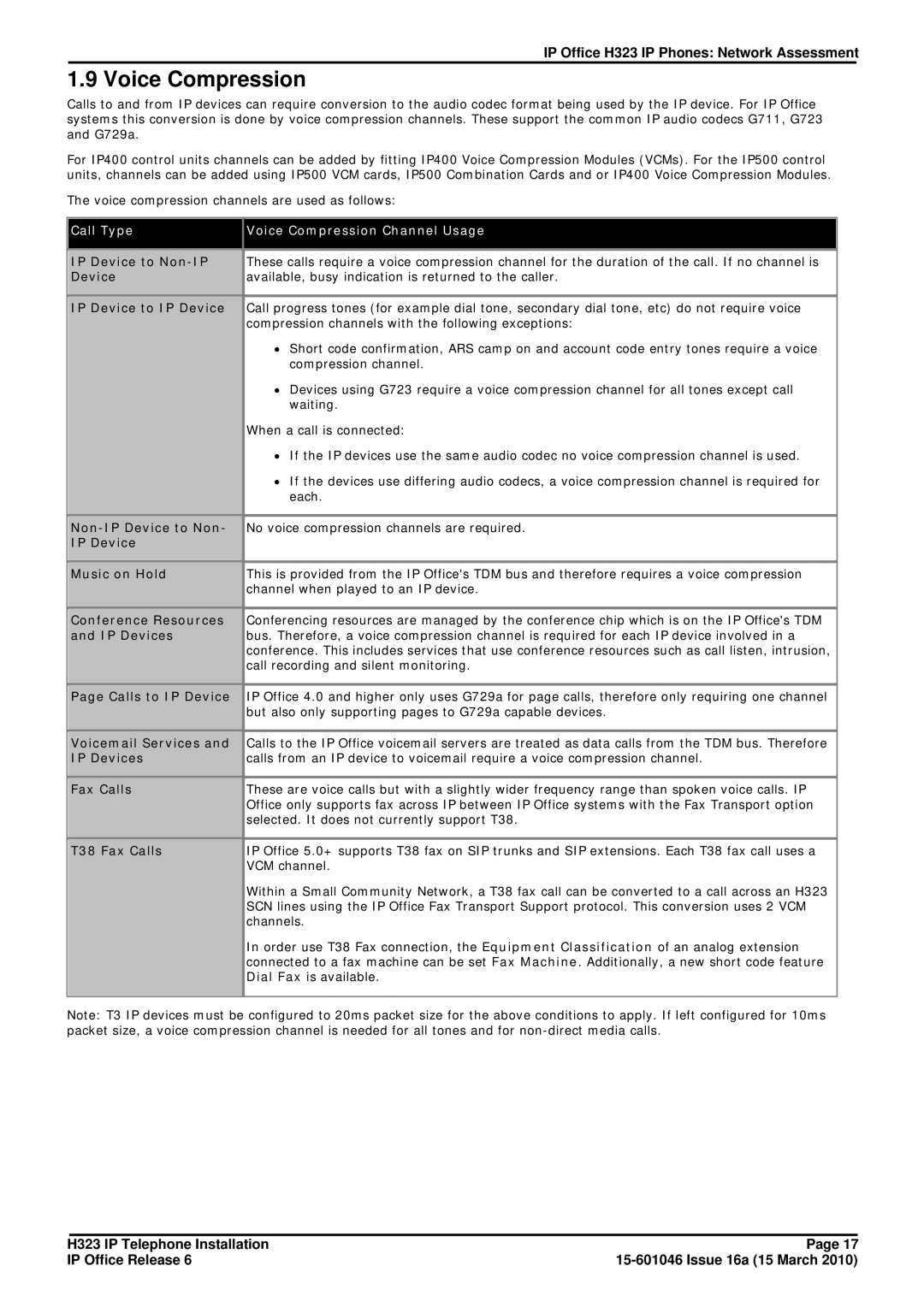
IP Office H323 IP Phones: Network Assessment
1.9 Voice Compression
Calls to and from IP devices can require conversion to the audio codec format being used by the IP device. For IP Office systems this conversion is done by voice compression channels. These support the common IP audio codecs G711, G723 and G729a.
For IP400 control units channels can be added by fitting IP400 Voice Compression Modules (VCMs). For the IP500 control units, channels can be added using IP500 VCM cards, IP500 Combination Cards and or IP400 Voice Compression Modules.
The voice compression channels are used as follows:
Call Type | Voice Compression Channel Usage | ||
|
| ||
IP Device to | These calls require a voice compression channel for the duration of the call. If no channel is | ||
Device | available, busy indication is returned to the caller. | ||
|
| ||
IP Device to IP Device | Call progress tones (for example dial tone, secondary dial tone, etc) do not require voice | ||
| compression channels with the following exceptions: | ||
| ∙ | Short code confirmation, ARS camp on and account code entry tones require a voice | |
|
| compression channel. | |
| ∙ | Devices using G723 require a voice compression channel for all tones except call | |
|
| waiting. | |
| When a call is connected: | ||
| ∙ | If the IP devices use the same audio codec no voice compression channel is used. | |
| ∙ | If the devices use differing audio codecs, a voice compression channel is required for | |
|
| each. | |
|
| ||
No voice compression channels are required. | |||
IP Device |
|
| |
|
| ||
Music on Hold | This is provided from the IP Office's TDM bus and therefore requires a voice compression | ||
| channel when played to an IP device. | ||
|
| ||
Conference Resources | Conferencing resources are managed by the conference chip which is on the IP Office's TDM | ||
and IP Devices | bus. Therefore, a voice compression channel is required for each IP device involved in a | ||
| conference. This includes services that use conference resources such as call listen, intrusion, | ||
| call recording and silent monitoring. | ||
|
| ||
Page Calls to IP Device | IP Office 4.0 and higher only uses G729a for page calls, therefore only requiring one channel | ||
| but also only supporting pages to G729a capable devices. | ||
|
| ||
Voicemail Services and | Calls to the IP Office voicemail servers are treated as data calls from the TDM bus. Therefore | ||
IP Devices | calls from an IP device to voicemail require a voice compression channel. | ||
|
| ||
Fax Calls | These are voice calls but with a slightly wider frequency range than spoken voice calls. IP | ||
| Office only supports fax across IP between IP Office systems with the Fax Transport option | ||
| selected. It does not currently support T38. | ||
|
| ||
T38 Fax Calls | IP Office 5.0+ supports T38 fax on SIP trunks and SIP extensions. Each T38 fax call uses a | ||
| VCM channel. | ||
| Within a Small Community Network, a T38 fax call can be converted to a call across an H323 | ||
| SCN lines using the IP Office Fax Transport Support protocol. This conversion uses 2 VCM | ||
| channels. | ||
| In order use T38 Fax connection, the Equipment Classification of an analog extension | ||
| connected to a fax machine can be set Fax Machine. Additionally, a new short code feature | ||
| Dial Fax is available. | ||
|
|
| |
Note: T3 IP devices must be configured to 20ms packet size for the above conditions to apply. If left configured for 10ms packet size, a voice compression channel is needed for all tones and for
H323 IP Telephone Installation | Page 17 |
IP Office Release 6 |
